Making News and Taking Action at ALPA's Annual Air Safety Forum
Panel Discussions, Keynote Speakers Delve Into Today’s Issues and Tomorrow’s Opportunities
By Air Line Pilot Staff
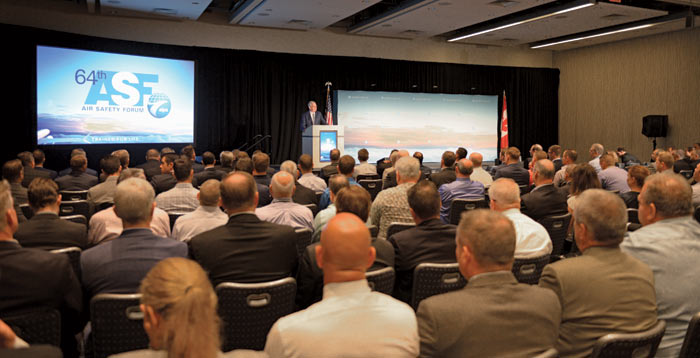
Capt. Tim Canoll, ALPA’s president, opens the 64th Air Safety Forum.
ALPA’s 64th Air Safety Forum kicked off in a big way on August 1 with a pair of announcements aimed at combating congressional efforts in the U.S. House of Representatives’ FAA reauthorization bill to eliminate pilots from the flight deck.
Capt. Tim Canoll, ALPA’s president, opened the two public days of the forum by highlighting the previous day’s release of a poll that indicates more than 80 percent of Americans aren’t ready for pilotless airplanes. An overwhelming 81 percent of those polled said they wouldn’t be comfortable on an airplane without pilots; two-thirds of those polled wouldn’t fly on a pilotless airplane even if prices were 30 percent lower than current prices. And nearly 70 percent stated that they opposed the proposed regulations providing for a government-funded study regarding the idea.
Canoll framed the effort as “save a buck or save a life,” and remarked, “It’s crystal clear that the flying public simply will not accept the lower level of safety that would result from taking pilots out of the cockpit.”
He also publicized an alliance to collectively fight this effort to weaken the safety of the airline industry. “I’m pleased to announce that more than 100,000 airline pilots from across the United States are joining forces to fight a reckless bid to remove pilots from the cockpit,” Canoll said. “The unions and trade associations representing the pilots of nearly 50 commercial airlines have formed an alliance to give voice to their unified opposition.”
Other members of the alliance include the Allied Pilots Association, the Coalition of Airline Pilots Associations, the Independent Pilots Association, the International Brotherhood of Teamsters, the NetJets Association of Shared Aircraft Pilots, and the Southwest Airlines Pilots Association. “The powerful unity of this alliance will be matched by our commitment to defend safety in our skies,” promised Canoll. “For our part, ALPA will use every resource we have to ensure that this antisafety provision is not enacted into law.”
In addition to the breaking news, Canoll expounded on the importance of the Air Safety Forum, remarking that pilots embody the meaning of “Trained for Life” and work every day to maintain “the unparalleled safety record our industry has experienced” and will continue their unwavering “efforts to keep flying safe and secure for years to come.”
Throughout the event, Canoll repeatedly acknowledged that “the most important safety assets on any airliner—cargo or passenger—are two adequately rested, fully qualified, and well-trained pilots,” noting that they “routinely perform the expected. But airline pilots must also be able to safely manage the unexpected.”
Continue reading on for coverage of panel discussions that delve into ALPA pilots’ work performing the expected and managing the unexpected as well as forum keynote speeches. Visit safetyforum.alpa.org for additional highlights, photos, and videos, and look for coverage of the forum’s private meeting days in the October issue.
Challenging legislation that could impact safety
In a segment titled “Existential Threat to the Profession,” Canoll and Capt. Bill Secord (FedEx Express), his pilot group’s Master Executive Council Legislative Affairs chair, discussed the background regarding the recent congressional effort to promote a taxpayer-funded program in support of single-pilot airline operations. Section 744 in the House version of the FAA reauthorization bill calls for a program to promote single-piloted operations of cargo airliners, supplementing this cockpit crew reduction with remote-piloting or computer-piloting technology.
“ALPA adamantly opposes FAA reauthorization Section 744 and will continue to use every resource we have to ensure that this antisafety provision is not enacted,” Canoll asserted.
Secord, who was appointed by Canoll to spearhead the Association’s efforts to thwart this legislative provision, provided a briefing on its origin and the degradation to safety and security it would create if enacted. He noted that the text was inserted by the House Science, Space, and Technology Committee late in the process with no discussion and no debate.
ALPA pilots were on Capitol Hill in mid-June talking to Members of Congress about the implications of Section 744, and the Association launched a corresponding news media campaign to communicate its concerns. Secord also discussed the alliance ALPA has formed with other airline pilot unions and trade associations to combat this provision.
Secord touched on the recent ALPA-commissioned Ipsos Group poll in which 81 percent of those surveyed said they wouldn’t be comfortable on a pilotless airplane. The same poll noted that 80 percent of the individuals surveyed felt that two pilots working together in the cockpit is the best option for problem solving while operating an aircraft.
“The evidence is clear,” said Secord, adding, “The general public is on our side.” He concluded by affirming that “safety should be priority number one, and the only way to do that is with two well-rested, well-trained pilots in the cockpit.”
Protecting against “dramatically increasing” dangers
Capt. Scott Schwartz (FedEx Express), director of ALPA’s Dangerous Goods program, moderated the panel titled “Fire in the Hold: Anticipating/Preventing Fires from Passenger-Checked Baggage.” “The number of portable electronic devices being carried by passengers on airlines has been dramatically increasing in recent years,” he stated. “Most of these devices are powered by lithium batteries that on rare occasions catch fire. Both regulators and the airline industry are acting to mitigate these developing hazards, but any effective policy will require passenger education and compliance—and this necessarily introduces unwanted inconvenience and complication to the customer experience.” (See below.)
Duane Pfund, the Pipeline and Hazardous Materials Safety Administration international program coordinator, observed, “We regulate batteries based on chemistry, size, and other metrics, but the biggest hazard comes from when a battery goes into ‘thermal runaway’ and propagates to other batteries and escalates into an unmanageable event. But what if there were a test-based scheme to determine if a battery is low-, medium-, or high-risk? From there, industry can tier the standards and work to meet those standards. In the near future, I see this as the way we move forward.”
Mike Tobin, International Air Transport Association (IATA) dangerous goods board member and dangerous goods manager for Alaska Airlines, detailed the problems associated with new technologies using lithium batteries, like smart luggage—travel bags with an integrated lithium ion battery. “There’s been a major push for these by their manufacturers to seek exemption,” he said. “But I’d rather have to explain why something was not on an airplane and being safe than why something was a problem. There’ve been a lot of operational challenges associated with these, resulting in delayed flights and even an air turn back to the airport.”
Capt. Mark Rogers (United), a former director of ALPA’s Dangerous Goods program, provided the line-pilot perspective: “Past accidents have shown that from the time an uncontrolled fire breaks out on an airplane, a flight crew has an average of 19 minutes to get the plane on the ground. We need to focus on regulations and prevention of lithium battery fires rather than fighting a fire that’s occurred because by the time a flight crew discovers a fire has broken out, it may be too late.”
Medical certification hot topics
Because medical certification is critically important to airline pilots, forum attendees had the opportunity to learn about hot-topic aeromedical issues in a panel discussion titled “Meet the Doctors.” Moderated by F/O Ellen Brinks (Delta), ALPA’s Aeromedical Group chair, the panel included Dr. Michael Berry, the FAA’s federal air surgeon; Dr. Jim Pfaff, director of medicine for the civil aviation branch of Transport Canada; and Dr. Quay Snyder, ALPA’s aeromedical advisor and president of the Aviation Medicine Advisory Service.
Brinks initiated the discussion, talking about the legalization of marijuana for both medicinal and personal use in parts of the United States and its impact on medical certification. Berry pointed out that while marijuana may be legal in certain states, its use remains illegal for airline pilots. “The real concern is that we don’t have data with regard to what is an impairing level,” he remarked, adding that a necessary wait period before pilots could fly again must be determined if policy is ever to be revised.
Pfaff noted that while possession of small amounts of marijuana and its recreational use will be legal in Canada this fall, it’s still banned for airline pilots. However, Canada doesn’t mandate random drug and alcohol testing for pilots, making it more difficult to identify offenders.
Snyder cautioned about pending legislation in Europe regarding drug and alcohol testing of crewmembers and preemployment formal psychological testing. He noted that there’s no movement in the United States or Canada for required psychological testing and that ALPA’s Pilot Peer Support program provides significantly better resources to optimize pilot mental health and safety.
“When you implement drug testing without a HIMS program [ALPA’s occupational substance abuse treatment program] that we have here in the U.S. and Canada, you’re really driving the problem underground,” said Snyder.
Panelists also discussed the ongoing opioid crisis and recent changes to U.S. pilot drug testing protocols, including the addition of four semisynthetic opioids. They also reviewed the timeframe for medical recertification following a pilot’s full recovery from a serious health event such as a stroke.
Pilot Peer Support, ALPA’s latest member resource
In a panel titled “Pilot Peer Support: The Next Phase in ALPA’s Approach to Pilot Wellness,” participants examined the union’s latest Pilot Assistance Group resource.
Moderated by Capt. Joe DePete, ALPA’s first vice president and national safety coordinator, the panel featured Snyder; F/O John Taylor (United), ALPA’s Pilot Assistance chair; Brinks; Marque Malan, ALPA’s aeromedical and human performance specialist; and Berry.
Kicking off the discussion, DePete described the events leading to the creation of ALPA’s Pilot Peer Support program, including the Germanwings Flight 9525 tragedy and the ensuing FAA Pilot Fitness Aviation Rulemaking Committee (ARC), of which he was a member. The ARC produced eight recommendations, including the need for air carriers to fully implement pilot peer support programs that specifically address life stress.
“After that, we had our ‘aha moment,’” DePete recalled, noting how a few larger master executive councils (MECs) had the vision and resources to start ’gold standard’ airline-specific peer programs. Canada’s ALPA pilots have had an established peer program since the 1970s. However, resource challenges at smaller U.S. MECs were driving a need to establish a U.S. pilot peer support network so that all ALPA pilots, regardless of MEC resources, would have 24/7 access to trained pilot peer support volunteers.
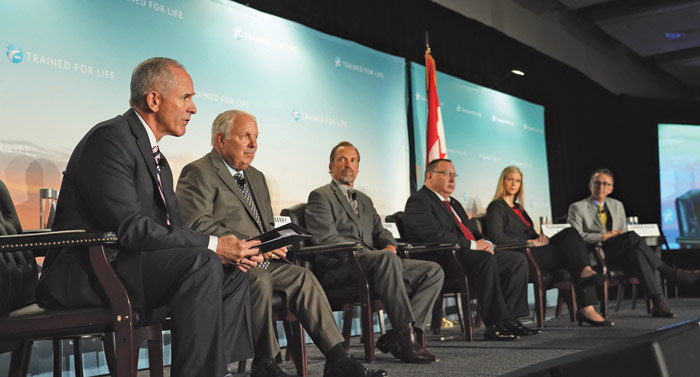
From left, Capt. Joe DePete, ALPA’s first vice president and national safety coordinator; Dr. Michael Berry, the FAA’s federal air surgeon; Dr. Quay Snyder, ALPA’s aeromedical advisor; F/O John Taylor (United), ALPA’s Pilot Assistance chair; F/O Ellen Brinks (Delta), ALPA’s Aeromedical Group chair; and Marque Malan, ALPA’s aeromedical and human performance specialist, discuss ALPA’s new Pilot Peer Support program.
Snyder noted that for this approach to be successful, “It’s critical to have pilots talking to pilots.”
While developing the ALPA pilot peer support program, Taylor, also a paramedic and registered nurse, provided input from his unique perspective. He noted, “The main focus is breaking down the stigma,” emphasizing that there’s no shame in asking for help.
In establishing a comparable system for ALPA member pilots, Brinks highlighted the “ALPA” plan regarding how Pilot Peer Support operates:
- Assess for needs and safety,
- Listen nonjudgmentally,
- Provide hope and encouragement, and
- Access appropriate resources.
Malan reviewed four basics of ALPA’s peer training, including active communication and effective listening, a general understanding of stress reactions peers are most likely to confront, pertinent legal and ethical concerns, and ALPA and community health resources. Berry, who was also a member of the pilot fitness ARC, discussed the enhanced training aviation medical examiners now undergo to aid pilots suffering from stress, depression, and other mental health concerns.
During the private days of this year’s forum, several volunteers participated in the new pilot peer support training course.
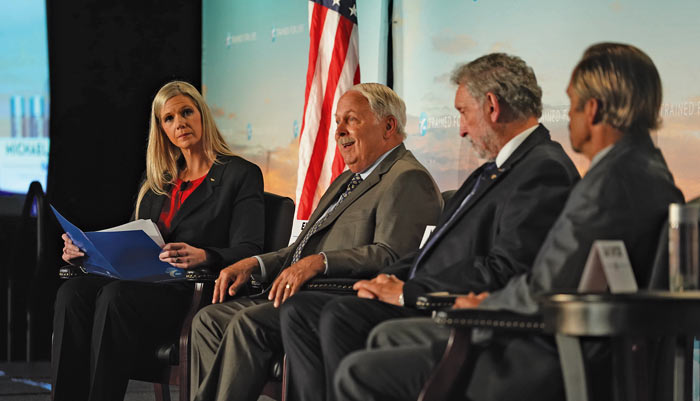
Dr. Michael Berry, the FAA’s federal air surgeon, second from left, notes that U.S. airline pilot drug testing protocols were updated earlier this year to include several categories of opioids.
Commercial space and shared airspace issues
“Recently, there’ve been more shared airspace issues,” said panel moderator Lori Garver, ALPA’s general manager and former NASA deputy administrator, as she opened the discussion titled “Commercial Space.” “While airline operations use the airspace for the majority of our flights, the space launch and return business uses it for only a few seconds…. There’s been an increasing focus on this issue of shared airspace, and ALPA is becoming more involved with the national discussion.”
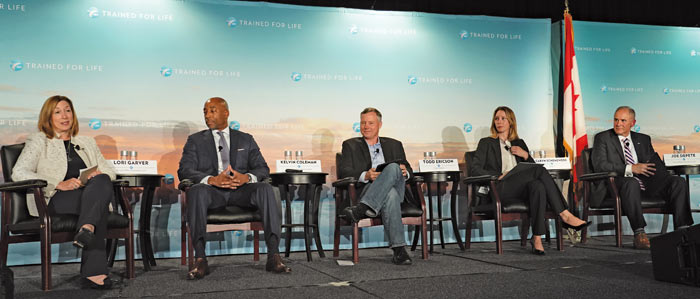
From left, Lori Garver, ALPA’s general manager; Kelvin Coleman, the FAA’s acting associate administrator for commercial space transportation; Capt. Todd Ericson, Virgin Galactic’s vice president of safety and flight test; Caryn Schenewerk, SpaceX’s senior counsel and director of space flight policy; and Capt. Joe DePete, ALPA’s first vice president and national safety coordinator, highlight their organization’s respective roles during the “Commercial Space” panel.
Kelvin Coleman, FAA acting associate administrator for commercial space transportation, discussed his office’s missions of ensuring the public’s safety and to encourage, facilitate, and promote the space industry. “There’s significant rulemaking under way right now,” he said, “since President Trump recently issued Space Policy Directive 2 to reform licensing, reentry, and other space-related regulations. We have a pretty aggressive goal in front of us now to streamline and consolidate outdated regulations to enable this industry.”
Capt. Todd Ericson, Virgin Galactic’s vice president of safety and flight test, spoke about his company developing a proactive safety culture following the 2014 loss of SpaceShipTwo. “At Virgin, we call it our North Star,” he explained. “We recognize that accomplishing anything worthwhile requires risks and that managing risks requires a reliable and true compass for our guidance on the journey—our North Star. So safety is our North Star in all decisions….”
DePete, who was a member of the panel, discussed ALPA’s involvement in licensing Spaceport Colorado at Front Range Airport, located under the congested airspace of Denver International Airport. “In the process of learning more about commercial space operations, I discovered a lack of communication and connection between those in aviation and space operations. And there are concerns surrounding segregated airspace,” he noted. “Are we taking advantage of all the tools and resources we have now to manage airspace better? There’s a discussion to be had, and ALPA is ready to lead it.”
Caryn Schenewerk, SpaceX’s senior counsel and director of space flight policy, pointed out that the increased reliability of rocket launches and recovery will decrease the impact on the national airspace system (NAS), especially with the development of new informational and planning tools.
Disruptive passengers jeopardize safety
According to IATA, more than 58,000 incidents of unruly passengers were recorded from 2007 to 2016. Security experts examined this safety concern in a panel titled “Disruptive Passengers: Keeping Problems Off the Airplane.”
F/O Matt Clark (Delta), his pilot group’s security chair and panel moderator, observed, “While unruly passengers might account for a small percentage of the traveling public, they can have a disproportionate impact on everyone else. Delays, misconnections, and diversions are just a few of the complications that can result.”
Christopher Bidwell, vice president of security for Airports Council International–North America, noted that intoxication is often a factor. Mike Everson, chief of the Minneapolis–St. Paul Metropolitan Airports Commission Police, talked about the presence of smartphones with video capabilities and how this affects law enforcement’s response. “Removing someone from an aircraft is often not pretty. Consequently, law enforcement is frequently asking airlines to deplane their aircraft in these situations.”
“This is an issue we face every single day on the job,” said Sara Nelson, president of the Association of Flight Attendants–CWA. She noted that passengers are fighting over issues as simple as carry-on bags and that instances of sexual harassment and assault are on the rise. The impact of unruly passengers “is the most disruptive issue we deal with in aviation today,” she added.
Alexy Orr, United Airlines’ manager of global aviation security compliance, remarked that more than 300 incidents were reported at United last year. She acknowledged that additional training is needed to help frontline employees better understand the resources available and how they should report these events.
“If there was ever a problem that needed a team approach, this seems to be it,” observed Stephen Moates, an FAA air safety inspector, who said that the FAA is committed to finding solutions to resolve these problems and that the regulatory process is part of that solution. But Moates noted that the aviation community needs to find additional strategies to deal with disruptive passengers.
“As important as the fuel on an airplane”
Leading a segment titled “Data Mining for Safer Skies,” Capt. Steve Jangelis (Delta), ALPA’s Aviation Safety chair, stated, “There’s a fallacy in safety reporting in which some pilots think, ‘My one report won’t change a thing.’ But that couldn’t be further from the truth. We’re at a point where we can predict and prevent accidents long before they happen, thanks to data.”
Capt. Michael Quiello, United Airlines’ vice president of corporate safety and a Commercial Aviation Safety Team cochair, noted, “With modern recording systems, a half terabyte of data is produced and collected on every flight. Because of all that information, we’re learning more about our systems and procedures and are doing things we never would have thought of a year and a half ago because of data.”
Capt. Michael Schilz (Delta), ALPA’s FOQA team leader, reiterated, “Every report, even sole-source reports, is critical to the system. We’re working to stop accidents. We’re closer than we’ve ever been, and these safety systems need data to do that.”
Capt. Neil Raaz, American Airlines’ Joint Implementation Measurement Data Analysis Team cochair, posed an interesting scenario: “Imagine you show up to your plane for a transatlantic flight and, an hour and half before your departure, you get an order for a tail number swap. You call dispatch to ask why and are told ‘Because the data indicates to us that that engine is going to fail in 7.2 hours.’ What are the safety implications of the data-driving component that can predict engine failures?”
Capt. Terry McVenes, Boeing’s director of system safety and regulatory affairs, remarked, “Data is as important as the fuel on an airplane, and sharing it is vital to systemwide improvements.”
Capt. Craig Hoskins, Airbus’s vice president of safety, security, and technical affairs, issued a challenge to safety representatives, asking them to “reach out to maintenance personnel at your carriers, as there is not only a depth of knowledge there to learn from, but a vast amount of untapped potential in terms of data to be harnessed.”
Protecting “a critically important resource”
“The airline jumpseat is a critically important resource for carriers and pilots alike,” said Capt. Rich Odbert (FedEx Express), ALPA’s Aviation Jumpseat chair, who moderated the panel discussion titled “Flight Deck Access in the Post-9/11 Age,” which explored jumpseat protections and improvements instituted in the post-9/11 era.
Odbert noted that the mission of ALPA’s Jumpseat Group “is to ensure PIC [pilot-in-command] control over flight deck access; that use of the jumpseat is not abrogated or undermined in any manner or under any circumstances; that flight deck jumpseats are made available to all individuals authorized to use them in accordance with PIC approval and federal requirements; and that appropriate procedures, equipment, and training are used to protect the safety and security of the flight deck and jumpseat.”
Bill Petrak, an FAA aviation safety inspector, pointed out that “in 2016, the agency conducted more than 37,000 flight inspections of airline carriers, including the flight deck and the passenger cabin, and there wasn’t one issue reported regarding flight deck security. However, the risk remains and is at its greatest when the cockpit door is open. While 9/11 was nearly 17 years ago, we should still act if it was yesterday when it comes to safeguarding that access.”
Capt. Rob Galbraith, United Airlines’ senior manager of line operations, observed, “Many airlines have automated the CASS [Cockpit Access Security System] process and—in the rush to push the airplane out—captains aren’t checking credentials. CASS doesn’t relieve the PIC of that responsibility. That’s something we must never lose sight of.”
Capt. Dave Webb (FedEx Express, Ret.), a former Master Executive Council chair for his pilot group, stated, “All the effort of the last 17 years has been to facilitate access safely. All the layers of security that exist today are intended to catch a problem, but they aren’t 100 percent foolproof…. The final authority belongs to the captain. You’re responsible, so you need to always ask the question ‘Is this person an enhancement to safety or an unknown?’”
Odbert concluded by asking pilots to “please make the walk. Preflight your jumpseat by asking the gate agent if there are any pilots requesting the jumpseat and make every effort to ensure that no pilot is left behind.”
Yes, please, to jumpseat etiquette
ALPA’s Aviation Jumpseat Group debuted a short video at the Air Safety Forum titled “Jumpseat Etiquette? Yes Please!” The video provides an overview of reciprocal jumpseating procedures and proper jumpseat etiquette.
It’s important to remember that a jumpseater, whether he or she sits in the cockpit or in the main cabin, is considered an additional member of the crew, per U.S. and Canadian aviation regulations.
For more information about jumpseating and ALPA’s Aviation Jumpseat Group, visit jumpseatinfo.org.
Addressing changes in the NAS
The panel titled “Pilots and Controllers—Managing Change in an Evolving NAS” examined the impact of ongoing technical and procedural changes being enacted across the NAS. Capt. Marc Henegar (Alaska), ALPA’s Air Traffic Services Group chair and panel moderator, highlighted three basic types of changes confronting users: changes in people, changes in procedures, and changes in threats. He noted that many pilots are now entering the profession at a younger age and with higher levels of education but sometimes with less experience than in the past.
Andy Marosvari, a National Air Traffic Controllers Association (NATCA) procedures representative, noted that NATCA is seeing more and more applicants without a strong background in aviation, which is leading to increased training and an experience gap.
Capt. John Drexler (United), ALPA’s director of Air Traffic Control Procedures, highlighted the increased need for mentorship for both ALPA and NATCA members. “You can’t learn what can only be experienced,” he explained. “Real-world experience is a form of knowledge that can’t be taught in a classroom or in a simulator. It’s the truest and most compelling form of instruction.”
Capt. Brian Townsend, a technical pilot for American Airlines, discussed “tribal knowledge,” and phraseology that newer pilots and controllers might not be aware of yet. “We’re doing more standardization across our fleets to combat this, which should make their training experience and transition much easier.”
Alex McDowell, the deputy executive director of the FAA’s Traffic Safety Oversight Service, provided an example of a new procedure causing potential issues. He noted that some airports were using data studies to adjust the standard wake separation between aircraft, but there were unintended consequences. A controller could be working with two different airports—one with and one without the new procedure—which could lead to confusion.
The group also addressed safety risk management and the uptick in commercial space operations before ending with a conversation about enroute datacomm. The main change regarding enroute datacomm, said Henegar, will be the “need to provide better pilot reports. We won’t be able to hear turbulence and weather reports on the radio” about issues aircraft in front of us are having with this new system.
Drexler closed by cautioning against a backlash to new things. “New isn’t bad,” he said. “It just presents challenges. When we come out of training, we’re all technically ready; but we have to find a conduit to bring the many decades of line experience being lost by pilot retirements to our new hires.”
Keynote Addresses
FAA acting administrator stresses importance of collaboration
“Regulation alone can’t achieve the kind of results we demand from aviation,” said FAA Acting Administrator Dan Elwell during ALPA’s Air Safety Forum. “We’re as safe as we are today because we collaborate.” He noted that in the last 20 years, commercial aviation fatalities in the United States have decreased by 95 percent.
Elwell talked about the safety culture that’s evolved within the U.S. airline industry, attributing its success to three key elements: nonpunitive voluntary reporting, risk management, and effective mitigation. “This has become the most effective way to allow for an open exchange of information while still ensuring compliance,” he remarked.
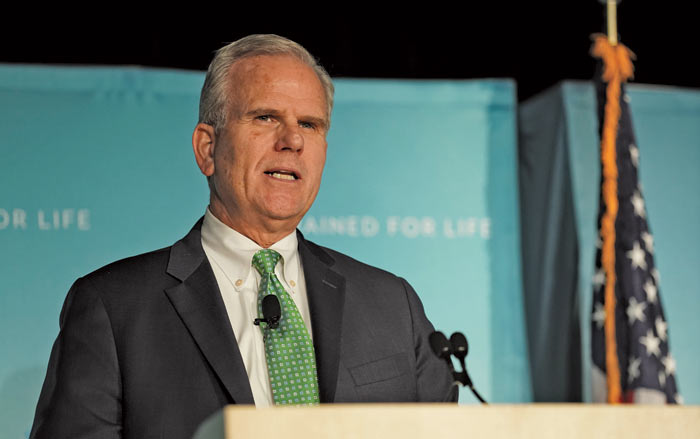
“Working with industry doesn’t lower the bar on safety; it’s what allows us to raise it even higher,” acknowledges Dan Elwell, acting FAA administrator.
As evidence of the success of this approach, Elwell pointed to a particular aviation incident. “Last year, a commercial airline crew landed on a taxiway instead of a runway at an airport without a control tower. The crew voluntarily reported the incident to the FAA. Since they knew they could speak freely without fear of reprisal, they were comfortable discussing exactly what happened.”
Elwell observed that the only lights the crew saw that night were from the airport’s taxiway and that pilot feedback led to the discovery of a flooded electrical box that had extinguished the runway lights. “The problem was fixed before another flight crew could make the same mistake,” he said, adding, “working with industry doesn’t lower the bar on safety; it’s what allows us to raise it even higher.”
The former American Airlines captain observed that the U.S. airline industry went nine years and roughly 90 million flights without a commercial aviation fatality, adding that “aviation is the only form of transportation on the planet where the idea of perfection actually seems within reach.” He personally acknowledged ALPA’s efforts, commenting that “this annual Air Safety Forum is a big reason we’re as safe as we are. I can’t overstate ALPA’s contribution to raising the safety bar.”
PHMSA Administrator Introduces “Check the Box” Campaign
ALPA’s efforts to mitigate the air transport of undeclared hazardous materials received a boost at the Air Safety Forum as Howard “Skip” Elliott, administrator of the Pipeline and Hazardous Materials Safety Administration (PHMSA), provided a sneak peek of an education campaign geared toward alerting the public about the dangers involved with inappropriately shipping lithium batteries and other hazardous materials.
The “Check the Box” campaign (checkthebox.dot.gov) aims to educate the public about potential shipping dangers, highlighting that “certain items that are essential to our daily lives—such as batteries and common household items—may seem harmless, but they can be toxic, corrosive, and even explosive if handled inappropriately.” The program’s goal is to “close a glaring gap in safety protocol—and save lives.”
Elliott acknowledged that “this important new safety initiative would not have become a reality if not for ALPA and its commitment to improving safety.”
Read more on this topic in the October issue.
Duckworth proves a strong ally
Sen. Tammy Duckworth (D-IL) earned a standing ovation at the Air Safety Forum with her strong comments supporting ALPA’s safety initiatives and her continuous efforts in the Senate working on behalf of ALPA pilots. A pilot herself (first with Blackhawks in the U.S. Army and now holding a private pilot’s certificate), Duckworth expressed her support for such ALPA initiatives as maintaining pilot training and qualification standards, the fight against single- and no-pilot cockpits, and the safe air transport of lithium batteries.
“I’ve always been proud of the level of professionalism of pilots,” she said, “and I really appreciate ALPA and all it does for that professionalism.”
Read Duckworth’s “Guest Commentary.”
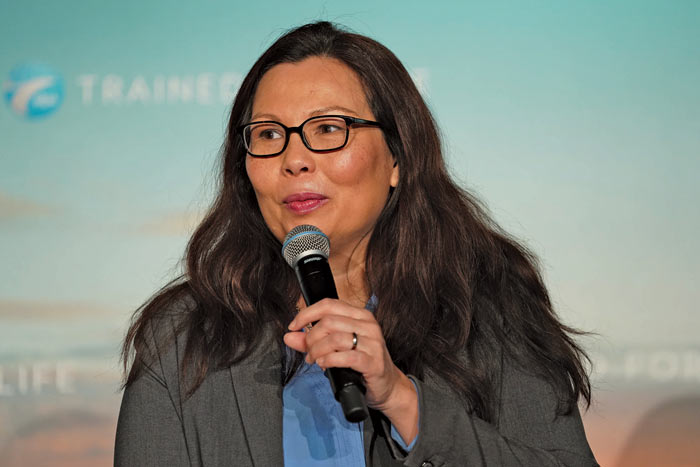
Sen. Tammy Duckworth (D-IL) provides a fellow pilot’s perspective on maintaining pilot training standards, single- and no-pilot cockpits, and the safe air transport of lithium batteries.
Developing a skilled workforce
Ed Wytkind, former president of the AFL-CIO’s Transportation Trades Department (TTD), addressed Air Safety Forum attendees about the role of unions in developing a skilled workforce.
“Having left the TTD, I’ve dived into this new ‘innovation space’ and now work on automated vehicles, robotics, and artificial intelligence,” he explained. “And there’s a feeding frenzy in this space. But there are indisputable truths.... You get the transportation you pay for, you get the safety and security standard you demand and enforce, and you get the skilled professionals you need when you pay them fairly and train them to uphold the highest safety standards—and give them a chance at not just a job, but a career. That is a fact, and what I think is the cornerstone of the transportation industry.
“Now we’re in this bubble…where the debate is between innovators and ‘the rest of us’ who, they say, impede progress,” Wytkind continued. “That is how Silicon Valley wants these innovations to be portrayed, and I reject that frame. ALPA, too, was built to reject that. It’s up to us, as the institutions involved in aviation and broader transportation issues, to make sure the tough questions are asked and to not allow the tough issues like safety to be sidestepped.
“This idea that we’re a bunch of Luddites in the labor movement is just wrong,” Wytkind asserted. “Safe transportation requires highly skilled workers, strong safety regulations, built-in redundancies, and persons and machines to work together and interface....” Removing human interaction with these machines is not a good idea, he remarked.
Sharing a commitment to excellence
Sen. Bob Casey (R-PA) provided participants of the Air Safety Forum with an impassioned appreciation for the work ALPA pilots do and explored the ways he’s supported the Association’s efforts. “I’ve been blessed to work with you to make our skies even safer,” said Casey.
“Thank you for the difficult work that you all do,” he continued. “That commitment to excellence, that training, and that professionalism allow us to have the safest skies in the world.”
Casey discussed secondary cockpit barriers and other issues that he tackles side by side with ALPA. “We’ve heard time and again from ALPA about the importance of secondary barriers,” he said. “Your feedback has been instrumental in crafting this legislation.” Casey called it “long, long overdue” and optimistically referred to “the light at the end of the tunnel” with its inclusion in the FAA reauthorization bill.
He also spoke about his efforts to combat sexual harassment and sexual assault on airlines. He quoted a recent survey by the Association of Flight Attendants–CWA in which one in five respondents reported seeing some form of harassment or assault in flight.
Together with other Members of Congress, Casey is one of the main proponents for developing guidance on harassment that includes airline personnel training, data collection, and timely responses. He called the effort bipartisan and noted that he had ALPA’s backing as well, thanking the Association for its support.
Casey concluded by referencing the current divisive political climate but still highlighted many areas in which bipartisanship has provided positive solutions. He reminded the pilots that they’re the best advocates for safety issues and to keep that in mind, encouraging them to make their voices heard.
Lack of stable funding could cripple airline Industry
Paul Rinaldi, president of NATCA, remarked to ALPA Air Safety Forum attendees that the lack of stable, predictable funding for the NAS, if left unchanged, could cripple the U.S. airline industry. “We’ve been living off short-term extensions, threats of shutdowns, and shutdowns for the last 10 years,” he said, asserting that “we’re falling further and further behind the rest of the world because they’re able to be dynamic to modernize their systems.”
Rinaldi observed, “All too often, we get handcuffed by bureaucratic process, the funding, and the reauthorizations,” pointing out that when new technology is approved, determining requirements, setting procedures, overseeing bidding, conducting testing, and other administrative processes unduly delay implementation.
In addition, he noted that the country needs to decide how it’s going to deal with new users to the NAS. “If commercial space pays nothing for blocking hundreds of thousands of miles of airspace for launches and reentries, then it will pay nothing 30 years from now when doing it three or four times a day,” he remarked.
The NATCA president suggested that providing direct access to the Aviation Trust Fund or Airport and Airway Trust Fund could help solve the agency’s funding concerns but added that action needs to be taken now.
“Together we moved nearly 965 million passengers on commercial flights last year. That’s a 5 percent increase from 2016, and we’re looking to cross the one billion mark this year. As capacity has grown, doing more with less doesn’t work. We have to find a way to create a stable, predictable funding for our aviation system,” said Rinaldi.
More photos


